|

Practical Electronics for Inventors

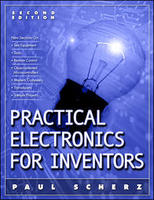 Here's
the book for every hobbyist who wants to be an inventor, but needs to learn the basics of
electronics to get there. In most introductory electronics books the emphasis is on
technical formulas and theory, while practical applications and advice often get lost in a
high-tech haze. Not very inspiring... Here's
the book for every hobbyist who wants to be an inventor, but needs to learn the basics of
electronics to get there. In most introductory electronics books the emphasis is on
technical formulas and theory, while practical applications and advice often get lost in a
high-tech haze. Not very inspiring...
Practical Electronics for Inventors, on the other hand, gives you information you
need, in a format you can work with. The simple step-by-step approach teaches the
fundamentals in a way that requires no background in electronics. Packed with
illustrations, the 750 hand-drawn images provide clear, detailed instructions on how to
turn theoretical ideas into working real-life gadgets.
This crystal-clear, learn-as-you-go guide shows you what a particular
device does, what it looks like, how it compares with similar devices, and how it is used
in applications. Written by Paul Scherz, a physicist who is also an inventor and
electrical hobbyist, this important reference provides beginning hobbyists and inventors
with an intuitive grasp of the theoretical and practical aspects of electronics--just the
kind of insight you need to get your projects up and running.
Starting with a light review of electronics history, physics, and math, the book provides
an easy-to-understand overview of all major electronic elements. Along with coverage of
integrated circuits (ICs), digital electronics, microcontrollers, and various input/output
devices, Practical Electronics for Inventors takes you through reading
schematics; building and testing prototypes; purchasing electronic components; and safe
work practices. You'll find all this--and more--in the guide that's destined to spur you
on to new levels of creativity. The ultimate inventor's guide!

Robot Programmer's Bonanza

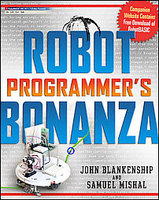 Get ready to reach into your programming toolbox and control a robot like
never before! Robot Programmer's Bonanza is the one-stop guide for everyone
from robot novices to advanced hobbyists who are ready to go beyond just
building robots and start programming them to perform useful tasks. Get ready to reach into your programming toolbox and control a robot like
never before! Robot Programmer's Bonanza is the one-stop guide for everyone
from robot novices to advanced hobbyists who are ready to go beyond just
building robots and start programming them to perform useful tasks.
Using the versatile RobotBASIC programming language, you'll discover how to
prototype your creative ideas using the integrated mobile robot simulator
and then port your finished programs to nearly any hardware/software
configuration. You can even use the built-in wireless protocol to directly
control real-world robots that can be built from readily available sensors
and actuators.
Start small by making your robot follow a line, hug a wall,
and avoid drop-offs or restricted areas. Then, enable your robot to perform
more sophisticated actions, such as locating a goal, sweeping the floor, or
navigating a home or office. Packed with illustrations and plenty of
inspiration, the unique Robot Programmer's Bonanza even helps you
teach your robot to become intelligent and adapt to its environment.
In this book you'll find everything you need to program and control a robot
including:
* In-depth coverage of the RobotBASIC simulator as well as how it can be
used to control real-world robots either directly or through the integrated
wireless protocol
* A free download of the full version of the
RobotBASIC robotic simulator and control language
* Remote control algorithms as well as autonomous behaviors
|
* Integrated debugger that facilitates program development
* Appendices that detail RobotBASIC's extensive commands and functions as
well as the integrated programming environment
* Adaptable and customizable programs that solve realistic problems-use
simulations to prototype robots that can mow a yard, deliver mail, or
recharge a battery, then port your algorithms to real-world robots
* Chapters devoted to creating contests with RobotBASIC and utilizing
RobotBASIC in the classroom to teach programming
|
|

Electronic Sensor Circuits & Projects

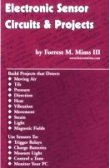 Electronic
sensor circuits convert light, temperature, sound, and other signals into a
form that can be processed by electronic circuits. Learn about solar cells,
photoresistors, thermistors, and magnet switches. Then build circuits that
respond to heat, pressure, light, and more. This Engineer's Mini Notebook is
a compilation of three of Forrest Mims's notebooks: Sensor Projects; Solar
Cell Projects; and Magnet & Magnet Sensor Projects. Electronic
sensor circuits convert light, temperature, sound, and other signals into a
form that can be processed by electronic circuits. Learn about solar cells,
photoresistors, thermistors, and magnet switches. Then build circuits that
respond to heat, pressure, light, and more. This Engineer's Mini Notebook is
a compilation of three of Forrest Mims's notebooks: Sensor Projects; Solar
Cell Projects; and Magnet & Magnet Sensor Projects.

Electronic Gadgets for the Evil Genius : 21
Build-It-Yourself Projects

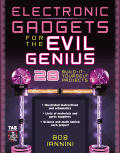 Electronics fans have waited a long time for this book. Not since 1983 has
author Bob Iannini published a collection of his amazing projects -- all of them fun,
easy, and inexpensive to make at home and, best of all, seriously exciting and impressive!
Iannini takes the stuff of science fiction and science future and brings it down to size
for the home hobbyist. Full of easy-to-follow plans and clear diagrams and schematics, Electronic
Gadgets for the Evil Genius gives you: Electronics fans have waited a long time for this book. Not since 1983 has
author Bob Iannini published a collection of his amazing projects -- all of them fun,
easy, and inexpensive to make at home and, best of all, seriously exciting and impressive!
Iannini takes the stuff of science fiction and science future and brings it down to size
for the home hobbyist. Full of easy-to-follow plans and clear diagrams and schematics, Electronic
Gadgets for the Evil Genius gives you:
* Illustrated instructions and plans for amazing pre-tested projects
advanced enough for sophisticated electronics enthusiasts but described in sufficient
detail to be built easily by newcomers
* Explanations of the science and math behind each project
* Frustration-free plans -- parts are listed, along with sources -- and most of these
projects can be built for $100 or less
This book equips you with complete plans, instructions, parts lists, and
sources for these wonderful projects:
Electromagnetic Mass Driver and launcher
Pyrotechnic Blaster and shock wave pulser
Magnetic Pulse Can Crusher
Robotic Circuits Disabler with Electromagnetic Pulse Generator
Object Catapult
Laser Beam Cutter
Body Heat Detector
Lightning Bolt Generator
Object Levitation Device
Infrared Viewer
Laser Listening System
Traveling Plasma Wave Generator
Multi Vortex Plasma Tornado
Working Star Wars-like Light Saber
Ultrasonic Microphone
Marx Impulse Generator
Ultrasonic shock projector
Sonic Phaser Cannon
Ion ray projector
Ultra bright green laser
Centrifuge Design
Vortex Smoke Ring Machine
Electronic Ventriloquism System
Several Tesla Coil Projects

PDA Robotics : Using Your Personal Digital Assistant to
Control Your Robot

 Build a robot that uses your PDA as a brain! The chasm between PDAs
and robots has been spanned, with PDA Robotics : Using Your Personal Digital Assistant
to Control Your Robot, an easy to read guide to integrating these two pieces of
technology into a single, remote controlled powerhouse. Build a robot that uses your PDA as a brain! The chasm between PDAs
and robots has been spanned, with PDA Robotics : Using Your Personal Digital Assistant
to Control Your Robot, an easy to read guide to integrating these two pieces of
technology into a single, remote controlled powerhouse.
Written in simple language by a renowned software designer
and robotics expert, this unique resource reveals innovative concepts and
designs, helping you to build your own PDA-controlled robot from the ground
up.
Perfect for hobbyists, students of electronics, and engineers alike, this
book is your ticket into the brave new world of PDA-controlled robots!
You'll be able to:
|
* Allow any PDA to communicate with and control your robot
* Establish a wireless RF link between your PDA and robot
* Acquire low-cost, standard, and easily obtainable components
* Learn about special software, control circuits, and interface ideas for creating
artificial life forms
* Customize modules easily
* Learn about room radar and sonar devices
* And much more! |
|

Hardware Hacking Projects for Geeks

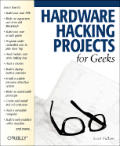 From How to Hack a Toaster to building Cubicle Intrusion Detection Systems, Hardware
Hacking Projects for Geeks offers an array of inventive customized electronics projects
for the geek who can't help looking at a gadget and wondering how it might be
"upgraded." From How to Hack a Toaster to building Cubicle Intrusion Detection Systems, Hardware
Hacking Projects for Geeks offers an array of inventive customized electronics projects
for the geek who can't help looking at a gadget and wondering how it might be
"upgraded."
Beginning with basic hacks, tools, and techniques for those who may
not have a background in electronics, the book covers the tools of the hardware hacking
trade and basic soldering techniques. Clear step-by-step instructions allow even those
with no formal electronics or hardware engineering skills to hack real hardware in very
clever ways.
This book provides detailed
instructions and materials lists for 15 projects. Each is rated in terms of
cost to build, level of difficulty, and time needed (usually a weekend,
although a few will take several weekends). Projects range
from those that are truly useful to some things you may have never thought to do, but
which are really cool, such as:
* Building your own arcade game
* Making radio-controlled cars play laser tag
* Building an automobile periscope
* Hacking an 802.11b antenna
* Making a building-size display
* Building an Internet-enabled toaster that imprints the weather
forecast on toast.
Perhaps you're an electronics hobbyist who likes to learn by doing. Maybe
you hack software and want to see how the other half lives. Or, maybe you've
never hacked at all, but you'd like to get started quickly with some
projects that do something interesting from the start. If you're any of
these, then Hardware Hacking Projects for Geeks will indulge your
inner mad scientist.

Controlling the World With Your PC

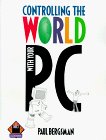 Controlling
the World With Your PC is not a manual from which you will learn the techniques of
world conquest and domination, as the title suggests, rather, it's a guide to interfacing
your PC to other devices and circuits. Controlling
the World With Your PC is not a manual from which you will learn the techniques of
world conquest and domination, as the title suggests, rather, it's a guide to interfacing
your PC to other devices and circuits.
Each of the circuits in this book connects directly to your parallel
printer port! Each also comes complete with a circuit diagram and listings for control
software written in Pascal, C, and BASIC. The accompanying disk contains full source code
in all the languages. Controlling the World With Your PC covers a vast array of interface
topics, from stepper motors to alarm systems to analog interface.
The text is clear and straightforward with useful discussion of the
circuit and the accompanying program. The programs are well documented so only basic
knowledge is necessary to get through the examples.
|
The book gives enough information to
facilitate further development of custom interfaces based on those in the book, or those
that are completely original. Paul Bergsman has done the hard work for you in this
terrific book for users of IBM compatible PCs. You won't need to modify your computer to
use this book.
|
|

Teach Yourself Electricity and Electronics

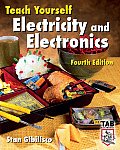 In
the field of introductory electronics, Stan Gibilisco wrote the book. This
gifted teacher/author is one of the most trusted names in popular
electronics and now he has updated his best-selling guide to reach audiences
interested in the latest electronic technologies. Like its predecessor, the
Fourth Edition of Teach Yourself Electricity
and Electronics is a complete self-teaching tool. Because it assumes no prior
technical knowledge, true novices can use it at their own pace to master the fundamentals
of electronics for work or hobbies. Gibilisco's proven blend of clear descriptions,
extensive illustrations, and numerous self-tests make this a true "stand-alone"
guide. In
the field of introductory electronics, Stan Gibilisco wrote the book. This
gifted teacher/author is one of the most trusted names in popular
electronics and now he has updated his best-selling guide to reach audiences
interested in the latest electronic technologies. Like its predecessor, the
Fourth Edition of Teach Yourself Electricity
and Electronics is a complete self-teaching tool. Because it assumes no prior
technical knowledge, true novices can use it at their own pace to master the fundamentals
of electronics for work or hobbies. Gibilisco's proven blend of clear descriptions,
extensive illustrations, and numerous self-tests make this a true "stand-alone"
guide.
Teach Yourself Electricity and Electronics has become the
standard introduction to the essentials of electricity and electronics. Now the author has
enhanced his best-selling guide with new chapters on cutting-edge technologies. The Third
Edition retains the classic user-friendly, self-study approach while bringing you
practical new information on wireless technologies, computers, and the Internet. Teach
Yourself Electricity and Electronics provides uniquely thorough coverage, ranging
from AC and DC concepts and circuits to semiconductors and integrated circuits.
Assuming no prior background in electronics, it features a conversational
writing style, quizzes, self-tests, and more than 500 illustrations that make learning
easier and livelier. In virtually no time at all you'll be able to: Make simple
current-voltage-resistance determinations; Design basic electronic circuits; Optimize
circuit efficiency; and much more! The book also provides new guidance to cellular
communications, transducers, wireless LANs and security systems, microprocessors, and
cyberspace. Whether you're a hobbyist, a technician, a professional in an
electronics-oriented firm, a student of electronics, or a novice, the new edition of Teach
Yourself Electricity and Electronics will be an essential reference you'll turn to
again and again.
|
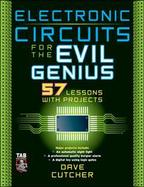 Electronic Circuits for the Evil Genius makes it fun to achieve genuine
mastery, one simple lesson at a time. What's more, when you're done, you'll
have five complete projects to show for your efforts! The book features 57
lessons that build on each other and add up to projects that you'll be proud
to display, play with, and put to practical use. You don't need to know
anything about electronics to begin building:
Electronic Circuits for the Evil Genius makes it fun to achieve genuine
mastery, one simple lesson at a time. What's more, when you're done, you'll
have five complete projects to show for your efforts! The book features 57
lessons that build on each other and add up to projects that you'll be proud
to display, play with, and put to practical use. You don't need to know
anything about electronics to begin building:  Here's
the book for every hobbyist who wants to be an inventor, but needs to learn the basics of
electronics to get there. In most introductory electronics books the emphasis is on
technical formulas and theory, while practical applications and advice often get lost in a
high-tech haze. Not very inspiring...
Here's
the book for every hobbyist who wants to be an inventor, but needs to learn the basics of
electronics to get there. In most introductory electronics books the emphasis is on
technical formulas and theory, while practical applications and advice often get lost in a
high-tech haze. Not very inspiring... Get ready to reach into your programming toolbox and control a robot like
never before! Robot Programmer's Bonanza is the one-stop guide for everyone
from robot novices to advanced hobbyists who are ready to go beyond just
building robots and start programming them to perform useful tasks.
Get ready to reach into your programming toolbox and control a robot like
never before! Robot Programmer's Bonanza is the one-stop guide for everyone
from robot novices to advanced hobbyists who are ready to go beyond just
building robots and start programming them to perform useful tasks. Electronic
sensor circuits convert light, temperature, sound, and other signals into a
form that can be processed by electronic circuits. Learn about solar cells,
photoresistors, thermistors, and magnet switches. Then build circuits that
respond to heat, pressure, light, and more. This Engineer's Mini Notebook is
a compilation of three of Forrest Mims's notebooks: Sensor Projects; Solar
Cell Projects; and Magnet & Magnet Sensor Projects.
Electronic
sensor circuits convert light, temperature, sound, and other signals into a
form that can be processed by electronic circuits. Learn about solar cells,
photoresistors, thermistors, and magnet switches. Then build circuits that
respond to heat, pressure, light, and more. This Engineer's Mini Notebook is
a compilation of three of Forrest Mims's notebooks: Sensor Projects; Solar
Cell Projects; and Magnet & Magnet Sensor Projects. Electronics fans have waited a long time for this book. Not since 1983 has
author Bob Iannini published a collection of his amazing projects -- all of them fun,
easy, and inexpensive to make at home and, best of all, seriously exciting and impressive!
Iannini takes the stuff of science fiction and science future and brings it down to size
for the home hobbyist. Full of easy-to-follow plans and clear diagrams and schematics, Electronic
Gadgets for the Evil Genius gives you:
Electronics fans have waited a long time for this book. Not since 1983 has
author Bob Iannini published a collection of his amazing projects -- all of them fun,
easy, and inexpensive to make at home and, best of all, seriously exciting and impressive!
Iannini takes the stuff of science fiction and science future and brings it down to size
for the home hobbyist. Full of easy-to-follow plans and clear diagrams and schematics, Electronic
Gadgets for the Evil Genius gives you: Build a robot that uses your PDA as a brain! The chasm between PDAs
and robots has been spanned, with PDA Robotics : Using Your Personal Digital Assistant
to Control Your Robot, an easy to read guide to integrating these two pieces of
technology into a single, remote controlled powerhouse.
Build a robot that uses your PDA as a brain! The chasm between PDAs
and robots has been spanned, with PDA Robotics : Using Your Personal Digital Assistant
to Control Your Robot, an easy to read guide to integrating these two pieces of
technology into a single, remote controlled powerhouse. From How to Hack a Toaster to building Cubicle Intrusion Detection Systems, Hardware
Hacking Projects for Geeks offers an array of inventive customized electronics projects
for the geek who can't help looking at a gadget and wondering how it might be
"upgraded."
From How to Hack a Toaster to building Cubicle Intrusion Detection Systems, Hardware
Hacking Projects for Geeks offers an array of inventive customized electronics projects
for the geek who can't help looking at a gadget and wondering how it might be
"upgraded." Controlling
the World With Your PC is not a manual from which you will learn the techniques of
world conquest and domination, as the title suggests, rather, it's a guide to interfacing
your PC to other devices and circuits.
Controlling
the World With Your PC is not a manual from which you will learn the techniques of
world conquest and domination, as the title suggests, rather, it's a guide to interfacing
your PC to other devices and circuits. In
the field of introductory electronics, Stan Gibilisco wrote the book. This
gifted teacher/author is one of the most trusted names in popular
electronics and now he has updated his best-selling guide to reach audiences
interested in the latest electronic technologies. Like its predecessor, the
Fourth Edition of Teach Yourself Electricity
and Electronics is a complete self-teaching tool. Because it assumes no prior
technical knowledge, true novices can use it at their own pace to master the fundamentals
of electronics for work or hobbies. Gibilisco's proven blend of clear descriptions,
extensive illustrations, and numerous self-tests make this a true "stand-alone"
guide.
In
the field of introductory electronics, Stan Gibilisco wrote the book. This
gifted teacher/author is one of the most trusted names in popular
electronics and now he has updated his best-selling guide to reach audiences
interested in the latest electronic technologies. Like its predecessor, the
Fourth Edition of Teach Yourself Electricity
and Electronics is a complete self-teaching tool. Because it assumes no prior
technical knowledge, true novices can use it at their own pace to master the fundamentals
of electronics for work or hobbies. Gibilisco's proven blend of clear descriptions,
extensive illustrations, and numerous self-tests make this a true "stand-alone"
guide.